The work of Frank Lloyd Wright is captured in coffee table books around the world, but this household name grew up right here in the Midwest. Wright is widely considered the greatest American architect of the 20th century, and his influential ideas about natural architecture, also known as Prairie style, were spawned in our own backyard.
For Peorians, that illustrated collection in the living room isn’t necessary—Wright built one of his first Prairie style houses right here, perhaps wanting to see if the idea would play. Years later, another local historical home followed suit. Join us as we unfold Frank Lloyd Wright’s ties to the Peoria area and celebrate the community that continues to hold its unique historical gems in high esteem.
The Man
On June 8, 1867, Wright was born in Richland Center, Wisconsin— less than 250 miles from Peoria. His father, William Cary Wright, was a Unitarian preacher and a musician, and his mother, Anna Lloyd Jones, was a teacher.
Before Wright was even born, his mother decided he was going to be an architect. To inspire him, she placed pictures of buildings on his bedroom walls and entertained him with geometric blocks, cardboard and paste.
His early life was nomadic until the age of 12, when the family settled in Madison. From that time on, Wright would spend summers on the farm with his uncle James Lloyd Jones. This time spent among the fields and wildlife influenced him deeply and is often cited as a defining aspect of Wright’s career.
In the next 70 years, Wright designed 1,141 structures— museums, churches, homes, bridges and more—but only 532 were actually built. As a testament to the structurally sound components of his work, 409 of the completed works still stand.
In addition to architecture, Wright also designed fabrics and furniture, authored 20 books and countless articles, lectured around the world and taught at his own school, Taliesin: The Frank Lloyd Wright School of Architecture. He passed away in Phoenix, Ariz. on April 9, 1959. He was 91.
The Prairie Style
From 1889 to 1909, the first 20 years of his career, Wright emphasized natural materials and sought to free Americans from Victorian “boxes”—houses which he saw as dark, closed-in and unnatural. He rejected the Chicago skylines filled with thin, sooty chimneys and ornate copies of historical buildings from overseas.
In February 1901, the Ladies Home Journal ran an article titled “A Home in a Prairie Town” featuring one of Wright’s residential floor plans. The article brought acknowledgement and approval from the residential market, and many designs were accepted within a year. The “Prairie” label stuck, and a new style of architecture was born.
Wright designed the Prairie homes to blend with the surrounding landscape, and as a result, many were characterized by low, horizontal lines. Gently sloping roofs replaced attics, there was often no basement and broad open rooms created flexible living space. Wright created a single large stone fireplace as the center of the house.
In keeping with his streamlined design, Wright avoided clutter and bulky Victorian furniture. He was often dismayed at the large couches and chairs clients were going to move into their new homes, so he began designing furniture and fabrics to be used instead. Bookcases and cupboards were built into the walls, and furniture often consisted of padded, built-in benches.
Oak was Wright’s favorite wood for prairie homes—he felt the strong, durable quality reflected the lifestyle accurately—and he used it for furniture, trim and building materials. He favored autumn colors, including deep browns, reds and tans, pairing them with neutral earth tones.
The first Prairie style home was the Ward Willits home, built in Highland Park, Ill. in 1902. Following on its heels was the Francis W. Little home in Peoria, completed in 1903.
Little House Off the Prairie
Businessman Francis W. Little was one of Wright’s first patrons. He helped fund the first major publication of Wright’s designs, which was printed in Berlin in 1910 by Ernst Wasmuth. This publication, now known as The Wasmuth Portfolio, helped secure international renown for Wright. As a result, Wright had a special affinity for the Little family, and he designed for them his first house in downstate Illinois.
The Little home in Peoria was built at 1505 W. Moss Ave., an area that featured prestigious businessmen in the early 1900s, says local architect Les Kenyon. It was an interesting addition to the neighborhood because all of the surrounding houses were in more traditional, ornate styles. According to Kenyon, the home was also unique for Wright, as elements of the design sometimes strayed from his Prairie style standards.
After the house was completed in 1903, the Little family lived there less than a year before moving to a suburb of Minneapolis. Less than a decade later, Wright again designed a home for them, considered the last of the Prairie style homes and the first built in Minnesota. It was demolished in 1972, but original furniture and even some rooms are preserved in the Metropolitan Museum of Art and other institutions.
Turning House Into Home
Since the time the Little family left the Peoria area, four homeowners have occupied the Wright house, but only the present family has allowed the community a glimpse inside.
For 45 years the Swardenski family has embraced the privilege of occupying a Wright house, enhancing the natural beauty of the structure with their Midwestern spirit and willingness to share Peoria’s own architectural gem.
The late Ruth Swardenski was an influential force in opening the home to the public. According to Marsha Swardenski, daughter- in-law to Ruth and her husband Walter, Ruth often drove by the house when she was young. Her father owned Lauterbach Lumber Company, and knowing the details of the house’s construction, Ruth was fascinated by it. Unfortunately, she could never go inside. A “For Sale” sign later changed all of that.
Homeowner Walter Swardenski and his youngest daughter, Holly Brown, recall the process of purchasing the home. Holly laughingly related that the family must have looked at every house in Peoria, and Walter described the tradition of driving along Moss Avenue with eager eyes. When a sign appeared in the Wright house’s lot, Ruth casually mentioned that the family should take a look. Six months later, after meetings with the then-owners and making what Walter describes as a shamefully modest offer, Walter received a surprising phone call. It was realtor Tracy Hammond saying, “Walter, you bought a house.” It was a dream come true for Ruth, and she felt compelled to share her home with the community, Marsha said.
Walter’s second youngest child, Lee, remembers his mother’s passion for restoring the home. “Mother, as soon as she got in here, said, ‘This is not Frank Lloyd Wright, what he intended,’” Lee said. Removing the dense lace curtains was the first step. Walter’s hunting pastime provided a theme for the home, and a design friend worked with Ruth until both agreed, “Frank would have liked this.”
The house is also surprisingly quiet, and noise made in one room doesn’t sneak past its own walls. Driving home from college during tornado weather, Holly said she remembers rushing for the home and its sanctuary. “I always felt…nothing would ever break down this house,” she said. “The house just wraps its arms around you when you come in the door; it’s a caretaker. I had complete faith in Frank for building such a product.”
For Holly, who passed her teenage years living in the home, the name Wright wasn’t as exciting as the people who visited. “Living in a Frank Lloyd Wright house meant you had to keep your room picked up because you never knew who was going to come to the house. At the drop of a hat you may be giving a house tour. A lot of times Mom and Dad both would see people outside taking pictures and they would go out and talk to them …they might find out they were from California and they’d invite them in. They truly tried to make Frank Lloyd Wright available to everyone.”
Ruth’s community involvement also kept the house filled with people. Walter said the family often hosted post-performance receptions for musical guests who entertained the Amateur Musical Club, of which Ruth was president for two terms. The visit of pianist Van Cliburn was a highlight, all the family members remembered. In addition, Ruth was once president of parent-teacher organizations at both Washington Grade School and Peoria High School. Informal piano lessons topped off a job description that also included being a mother, grandmother, wife and homemaker.
Despite the many visitors, for the Swardenskis, family is the most important aspect of a home. Their large living and dining rooms teeming with relatives composed many happy memories.
“The Christmas memories are the best here, growing up,” Lee reminisced. “In the early years, the late ’60s, early ’70s, we would all come here, all the children and all the grandchildren, and we would all be here on Christmas Eve. I can remember one time this whole room was filled with gifts, from the wall almost to the door.”
When giving friends a private tour of the home, Lee’s wife Marsha said she makes sure to begin with the same important words: “Welcome to the house that Frank Lloyd Wright built, but welcome to the home of Ruth and Walter Swardenski.”
“That’s really the story that I wanted them to leave with,” she said. “A respect for the person who built this house but an understanding that this really was a home, of Ruth and Walter; that they shared with this community and it was a part of them.”
Respecting History, Reflecting Personality
The house located at 1316 W. Moss Ave. is Peoria’s other Wright-esque structure. Long rumored to have been designed and later abandoned by Wright, the home has an obvious influence.
According to the present owners, Dr. Lindsey and Kathy Ma, the house was erected in 1913 after being commissioned by Deloss Brown Jr. The developer of High Point, Brown wanted a Wright style, but his wife, Vonna Ritchie Brown, cherished a passion for English and French antiques and constantly battled for a traditional home. A compromise resulted in a Prairie style home and a fascinating story.
Much like the Swardenski family, Lindsey said the home caught his eye when driving down Moss Avenue. A long-time admirer of Wright, he purchased the home as soon as it came on the market in 2005. After a year and a half of restoration, the Ma family finally moved in.
During the remodeling process, the history of the home has unfolded, Kathy said. Old bank notes, report cards and coins appeared. Original stain colors and undocumented changes to the structure of the house were revealed, and in some cases, restored. Wiring and plumbing systems were overhauled, and the kitchen now sports the newest appliances, making it perfect for entertaining.
The family is dedicated to salvaging many of the home’s key features, including the Prairie style leaded glass windows. Old trim was turned into bathroom cabinets, earth-toned paint graced the walls and unique lighting, such as hand-blown glass fixtures, created a new twist on some of Wright’s favorite focal points. The family’s hard work was honored with the 2006 Historic Preservation Award for Historic Home Restoration from the Peoria Historical Society.
For Kathy and Lindsey, it’s important to respect the history of the house yet make it into their own home. Lindsey admitted with a smile that the house would have looked much different if it had actually been done by Wright, but the couple enjoys combining their personal tastes for a creative, colorful home.
As President of the Peoria Art Guild, Lindsey’s massive collection of vintage posters and sculpture appropriately fills every wall and side table. Kathy compares herself to Vonna Ritchie because of her love of French antiques, and her collection of silver pieces is placed throughout the home.
The journey of restoring the house is still in progress with the old greenhouse and surrounding landscape. However, the Mas often entertain and hold fundraising dinners in their home both because of their own and the home’s connection to the community.
“We feel the history of Peoria is important to the future of Peoria,” Kathy said. “The Moss-Bradley area is rich with great stories of Peoria’s early history. Many of the families that built these houses also built Peoria. The great old neighborhoods give a foundation to the new neighborhoods.” a&s


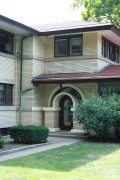 Located at 1505 W. Moss Ave., the Swardenski home was created at the advent of the prairie style in 1904. More than a century later, this hidden gem in the Peoria community has needed no major renovations.
Located at 1505 W. Moss Ave., the Swardenski home was created at the advent of the prairie style in 1904. More than a century later, this hidden gem in the Peoria community has needed no major renovations.  The lush greenery surrounding the home has been left just as Wright would have wanted it: a natural, protective gate of waist-high flowers.
The lush greenery surrounding the home has been left just as Wright would have wanted it: a natural, protective gate of waist-high flowers.
 Ruth and Walter Swardenski restored their home so that it accurately reflected the views of Wright. The fireplace, below, is the backbone of the structure, extending both to the basement and master bedroom. The dining room features rows of twin glass inserts, which allow natural light to softly filter in, while wooden beams sweep across the ceiling and down the walls to create an intimate feel.
Ruth and Walter Swardenski restored their home so that it accurately reflected the views of Wright. The fireplace, below, is the backbone of the structure, extending both to the basement and master bedroom. The dining room features rows of twin glass inserts, which allow natural light to softly filter in, while wooden beams sweep across the ceiling and down the walls to create an intimate feel.


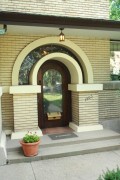

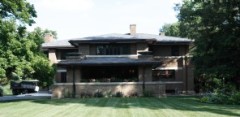


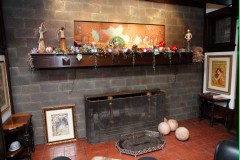
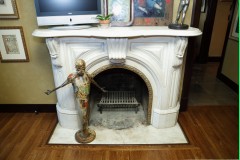 This French-inspired fireplace in the master bedroom was allegedly one of the sore points between Vonna Ritchie Brown and Wright when the house was under construction.
This French-inspired fireplace in the master bedroom was allegedly one of the sore points between Vonna Ritchie Brown and Wright when the house was under construction.
